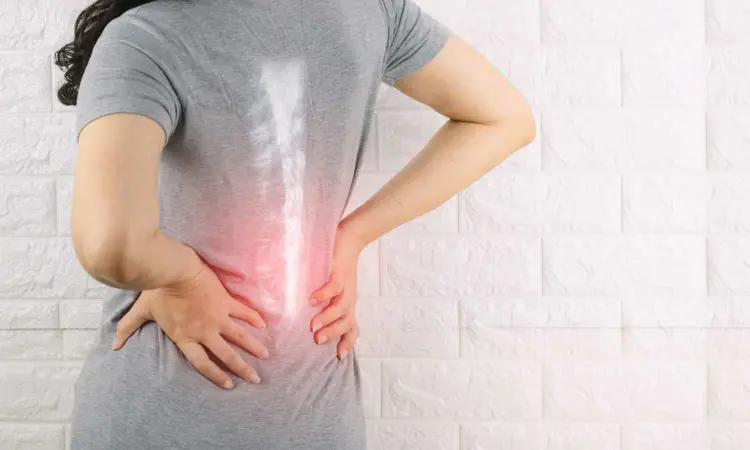- Home
- Medical news & Guidelines
- Anesthesiology
- Cardiology and CTVS
- Critical Care
- Dentistry
- Dermatology
- Diabetes and Endocrinology
- ENT
- Gastroenterology
- Medicine
- Nephrology
- Neurology
- Obstretics-Gynaecology
- Oncology
- Ophthalmology
- Orthopaedics
- Pediatrics-Neonatology
- Psychiatry
- Pulmonology
- Radiology
- Surgery
- Urology
- Laboratory Medicine
- Diet
- Nursing
- Paramedical
- Physiotherapy
- Health news
- Fact Check
- Bone Health Fact Check
- Brain Health Fact Check
- Cancer Related Fact Check
- Child Care Fact Check
- Dental and oral health fact check
- Diabetes and metabolic health fact check
- Diet and Nutrition Fact Check
- Eye and ENT Care Fact Check
- Fitness fact check
- Gut health fact check
- Heart health fact check
- Kidney health fact check
- Medical education fact check
- Men's health fact check
- Respiratory fact check
- Skin and hair care fact check
- Vaccine and Immunization fact check
- Women's health fact check
- AYUSH
- State News
- Andaman and Nicobar Islands
- Andhra Pradesh
- Arunachal Pradesh
- Assam
- Bihar
- Chandigarh
- Chattisgarh
- Dadra and Nagar Haveli
- Daman and Diu
- Delhi
- Goa
- Gujarat
- Haryana
- Himachal Pradesh
- Jammu & Kashmir
- Jharkhand
- Karnataka
- Kerala
- Ladakh
- Lakshadweep
- Madhya Pradesh
- Maharashtra
- Manipur
- Meghalaya
- Mizoram
- Nagaland
- Odisha
- Puducherry
- Punjab
- Rajasthan
- Sikkim
- Tamil Nadu
- Telangana
- Tripura
- Uttar Pradesh
- Uttrakhand
- West Bengal
- Medical Education
- Industry
Vasomotor symptoms closely associated with low BMD in postmenopausal women

A recent study published in the recent edition of Osteoporosis International journal highlight the relationship between vasomotor symptoms (VMS) and bone health in peri- and postmenopausal women. Vasomotor symptoms includes hot flashes, night sweats and have long been recognized as common and distressing experiences for the women who transition through menopause.
The study was conducted by the team of Panagiotis Anagnostis who systematically reviewed and meta-analyzed the existing evidence to investigate the association of VMS with fracture risk and bone mineral density (BMD). The findings were derived from a comprehensive analysis of twenty studies that involved nearly 50,000 women and provide valuable insights into this previously underexplored area.
The outcomes of this research revealed that while VMS did not significantly increase the risk of fractures in postmenopausal women, they were strongly associated with low BMD which is a key indicator of bone health. Specifically, the women who experienced VMS were found to have a 54% increased likelihood of having low BMD when compared to the individuals without such symptoms. This association was more pronounced in the lumbar spine with a significant decrease in BMD observed.
Importantly, the conclusions of this study remained consistent even after accounting for factors such as the severity of VMS, age and study design. Furthermore, the association between VMS and low BMD persisted when the analysis was limited to the studies that excluded the use of menopausal hormone therapy by indicating the robustness of the findings.
Overall, the findings of this study have significant outcomes for the management of the postmenopausal health in women. While VMS may not directly increase the fracture risk, their association with reduced BMD illuminates the importance of addressing these symptoms early on to reduce the potential long-term effects on bone health.
These studies continue to look deeper into the complex interplay between menopause-related symptoms and the various aspects of women's health that contribute to the valuable evidence which can guide the clinical practice and improve the quality of life for postmenopausal women. The findings underline the need for holistic approaches to menopausal care that prioritize both symptomatic management and the preservation of bone health.
Source:
Anagnostis, P., Lallas, K., Pappa, A., Avgeris, G., Beta, K., Damakis, D., Fountoukidou, E., Zidrou, M., Lambrinoudaki, I., & Goulis, D. G. (2024). The association of vasomotor symptoms with fracture risk and bone mineral density in postmenopausal women: a systematic review and meta-analysis of observational studies. In Osteoporosis International. Springer Science and Business Media LLC. https://doi.org/10.1007/s00198-024-07075-8
Neuroscience Masters graduate
Jacinthlyn Sylvia, a Neuroscience Master's graduate from Chennai has worked extensively in deciphering the neurobiology of cognition and motor control in aging. She also has spread-out exposure to Neurosurgery from her Bachelor’s. She is currently involved in active Neuro-Oncology research. She is an upcoming neuroscientist with a fiery passion for writing. Her news cover at Medical Dialogues feature recent discoveries and updates from the healthcare and biomedical research fields. She can be reached at editorial@medicaldialogues.in
Dr Kamal Kant Kohli-MBBS, DTCD- a chest specialist with more than 30 years of practice and a flair for writing clinical articles, Dr Kamal Kant Kohli joined Medical Dialogues as a Chief Editor of Medical News. Besides writing articles, as an editor, he proofreads and verifies all the medical content published on Medical Dialogues including those coming from journals, studies,medical conferences,guidelines etc. Email: drkohli@medicaldialogues.in. Contact no. 011-43720751


